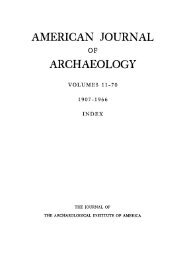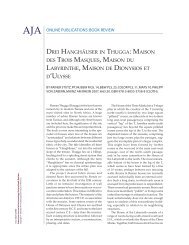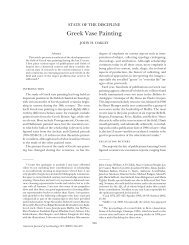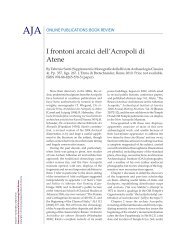AJA Online PublicatiOns - American Journal of Archaeology
AJA Online PublicatiOns - American Journal of Archaeology
AJA Online PublicatiOns - American Journal of Archaeology
Create successful ePaper yourself
Turn your PDF publications into a flip-book with our unique Google optimized e-Paper software.
Osteological Research in Classical <strong>Archaeology</strong>: Extended Bibliography<br />
Michael MacKinnon<br />
Nazionale del Collegio dei Docenti di Odontoiatria,<br />
541–46. Rome: Collegio dei Docenti di Odontoiatra.<br />
Torino, M., A. Menconi, and G. Fornaciari. 1997.<br />
“Le protesti dentarie auree nei gruppi umani a<br />
cultura Etrusca.” In Aspetti della cultura di Volterra<br />
etrusca fra l’età del ferro e l’età ellenistica e contributi<br />
della ricerca antropologica alla conoscenza del popolo<br />
etrusco (Atti del XIX Convegno di Studi Etruschi ed<br />
Italici (Volterra, 15–19 ottobre 1995), 535–44. Florence:<br />
Leo S. Olschki.<br />
Torino, M., M. Rognini, and G. Fornaciari. 1995.<br />
“Dental Fluorosis in Ancient Herculaneum.”<br />
Lancet 345(8960):1306.<br />
Tsaliki, A. 2002. “The Capestrano Warrior: Artistic<br />
Caprice or Disease?” Paleopathology Newsletter<br />
119:3–11.<br />
Tsilivakos, M.G., S.K. Manolis, O. Vikatou, and M.J.<br />
Papgrigorkis. 2002. “Periodontal Disease in the<br />
Mycenean (1450–1150 B.C.) Population <strong>of</strong> Aghia<br />
Triada, W. Peloponnese, Greece.” International<br />
<strong>Journal</strong> <strong>of</strong> Anthropology 17(2):91–9.<br />
Waldron, H.A. 1973. “Mediterranean Anaemia in<br />
Antiquity.” British Medical <strong>Journal</strong> 2(5867):667.<br />
———. 1982. “Lead in Bones: A Cautionary Tale.”<br />
Ecology <strong>of</strong> Disease 1(2–3):191–96.<br />
———. 2000. “A Case <strong>of</strong> Dyschondrosteosis from<br />
Roman Britain.” <strong>Journal</strong> <strong>of</strong> Medical Genetics<br />
37(10):E27.<br />
Waldron, H.A., and C. Wells. 1979. “Exposure to<br />
Lead in Ancient Populations.” Transactions and<br />
Studies <strong>of</strong> the College <strong>of</strong> Physicians <strong>of</strong> Philadelphia<br />
1(2):102–15.<br />
Weaver, D.S., G.H. Perry, R. Macchiarelli, and L.<br />
Bondioli. 2000. “A Surgical Amputation in 2nd<br />
Century Rome.” Lancet 356:686.<br />
Wittmers, L., Jr., A. Aufderheide, G.R. Rapp, and<br />
A. Alich. 2002. “Archaeological Contributions<br />
<strong>of</strong> Skeletal Lead Analysis.” Accounts <strong>of</strong> Chemical<br />
Research 35(8):669–75.<br />
Zafeiratos, C. 1988. “Anthropology and Paleopathology<br />
Research in Greece.” Paleopathology<br />
Newsletter 62:9–10.<br />
Zias, J. 1998. “Crucifixion in Antiquity: The Paleopathological<br />
Evidence.” Paleopathology Newsletter<br />
104:7–10.<br />
Aging, Sexing, and Osteometrics<br />
The following list represent a selection <strong>of</strong><br />
works dealing with issues about aging, sexing,<br />
or measuring human bone remains from classical<br />
archaeological sites. Many early analyses<br />
in physical anthropology concentrated on measuring<br />
bones, in particular human crania, and<br />
using these data to infer population categories<br />
and “races” <strong>of</strong> humans.<br />
Argenti, M., and G. Manzi. 1988. “Morfometria<br />
cranica delle popolazioni romane di eta imperiale:<br />
Isola Sacra e Lucus Feroniae.” Rivista di<br />
Antropologia 66:179–200.<br />
Bertholon, L. 1890. “Note sur deux crânes phénicienes<br />
trouvés en Tunisie.” L’Anthropologie 1. Paris.<br />
Coppa, A., A. Cucina, D. Mancinelli, R. Vargiu, and<br />
J.M. Calcagno. 1998. “Dental Anthropology <strong>of</strong><br />
Central-Southern, Iron Age Italy: The Evidence<br />
<strong>of</strong> Metric Versus Nonmetric Traits.” <strong>American</strong><br />
<strong>Journal</strong> <strong>of</strong> Physical Anthropology 107:371–86.<br />
Cresta, M., and F. Vecchi. 1969. “Caratteri metrici e<br />
morfologici in tre gruppi di antiche popolazioni<br />
dell’Italia.” Rivista di Antropologia 56:187–98.<br />
Guesa, G., L. Bondioli, E. Capucci, A. Cipriano, G.<br />
Grupe, C. Savorè, and R. Macchiarelli. 1999.<br />
Osteodental Biology <strong>of</strong> the People <strong>of</strong> Portus Romae<br />
(Necropolis <strong>of</strong> Isola Sacra, 2nd–3rd Cent. A.D.). Vol.<br />
2, Dental Cementum Annulations and Age at Death<br />
Estimates. Rome: Soprintendenza Speciale al<br />
Museo Nazionale Preistorico Etnografico.<br />
Lalueza Fox, C., A. González Martín, and S. Vives<br />
Civit. 1996. “Cranial Variation in the Iberian Peninsula<br />
and the Balearic Islands: Inferences About<br />
the History <strong>of</strong> the Population.” <strong>American</strong> <strong>Journal</strong><br />
<strong>of</strong> Physical Anthropology 99:413–28.<br />
Kron, G. 2005. “Athropometry, Physical Anthropology,<br />
and the Reconstruction <strong>of</strong> Ancient Health,<br />
Nutrition, and Living Standards.” Historia 54:<br />
68–83.<br />
Manzi, G., E. Santandrea, and P. Passarello. 1997.<br />
“Dental Size and Shape in the Roman Imperial<br />
Age: Two Examples from the Area <strong>of</strong><br />
Rome.” <strong>American</strong> <strong>Journal</strong> <strong>of</strong> Physical Anthropology<br />
102:469–79.<br />
Pinto-Cisternas, J., J. Moggi-Cecchi, and E. Pacciani.<br />
1995. “A Morphological Variant <strong>of</strong> the Permanent<br />
Upper Lateral Incisor in Two Tuscan Samples<br />
from Different Periods.” In Aspects <strong>of</strong> Dental<br />
Biology: Palaeontology, Anthropology and Evolution,<br />
edited by J. Moggi-Cecchi, 333–39. Florence: International<br />
Institute for the Study <strong>of</strong> Man.<br />
Powell, J.E. 1989. “Metric Versus Non-Metric Skeletal<br />
Traits: Which is the More Reliable Indicator<br />
<strong>of</strong> Genetic Distance? With Special Reference to<br />
Crania from Ancient Greece and Egypt.” Ph.D.<br />
diss., University <strong>of</strong> Bristol.<br />
Roudesli-Chebbi, S. 1994. “Étude anthropo-métrique<br />
des crânes puniques de Carthage.” Africa<br />
13:7–26.<br />
———. 1995. “A propos des cranes puniques de<br />
Carthage.” Reppal 9:189–202.<br />
———. 1996. “Étude du calvarium du squelette de la<br />
colline de Byrsa.” Centre d’études et de documentation<br />
archéologique de la Conservation de Carthage,<br />
Bulletin 15:34–9.<br />
Tocheri, M.W., and J.E. Molto. 2002. “Aging Fetal<br />
and Juvenile Skeletons from Roman Period Egypt<br />
Using Basiocciput Osteometrics.” International<br />
<strong>Journal</strong> <strong>of</strong> Osteoarchaeology 12:356–63.<br />
Vecchi, F. 1969. “Caratteri discontinui del cranio in<br />
antiche popolazioni dell’Italia.” Rivista di Antropologia<br />
56:157–74.<br />
Ritual and Sacrifice<br />
The following investigate aspects <strong>of</strong> ritual<br />
and sacrifice in classical archaeology on the basis<br />
<strong>of</strong> recovered osteological materials. In many<br />
cases they represent analyses <strong>of</strong> votive deposits<br />
or cemetery deposits, which presumably<br />
have some ritual or ceremonial connection.








